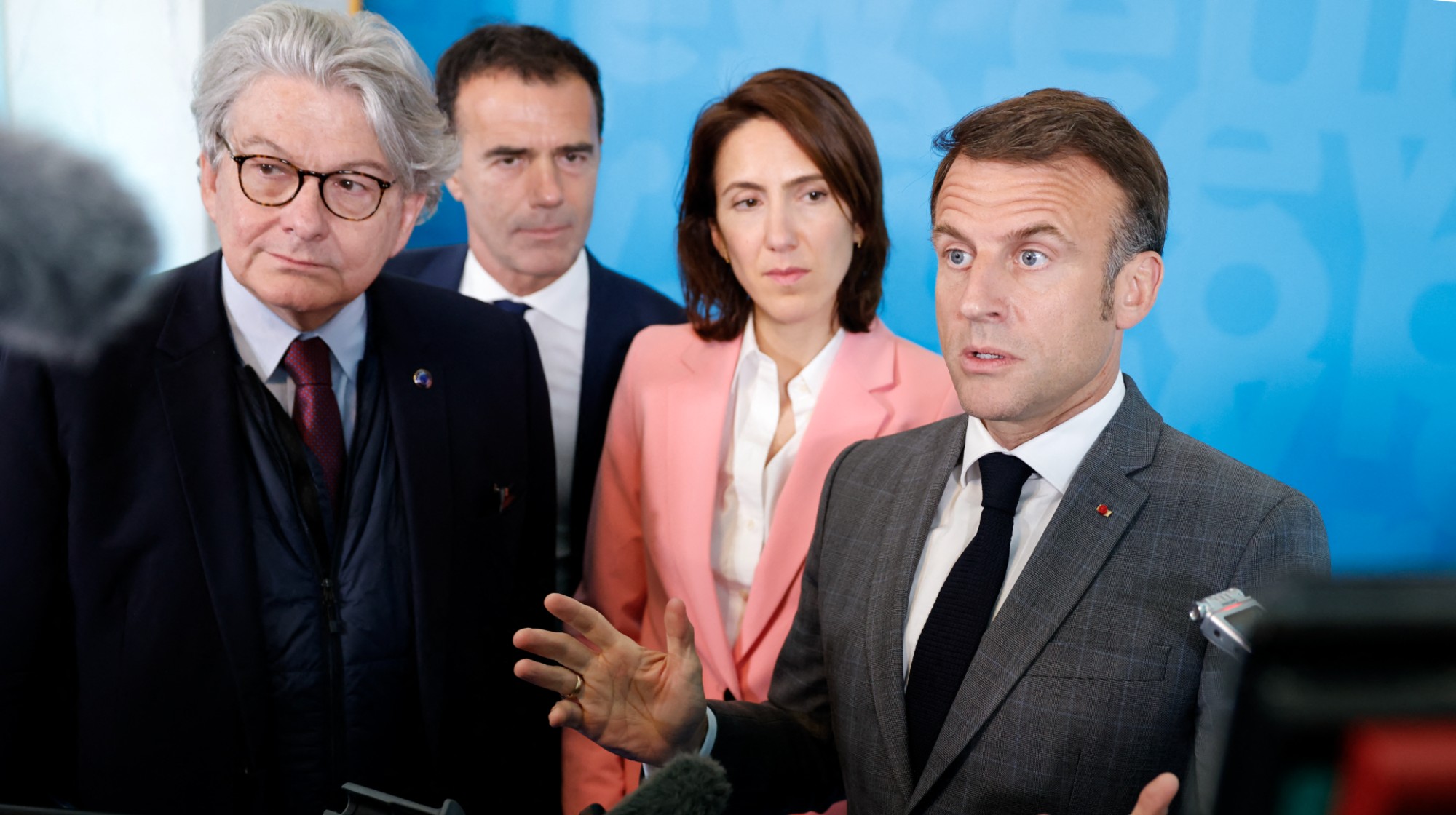The last word: Marketing Osama
America and al Qaida can be thought of as rival global brands competing for the hearts and minds of millions, says Radar
In October 1967, an Irish leftist named Jim Fitzpatrick was mourning the death of one of his heroes. Ernesto “Che” Guevara had been executed in a Bolivian schoolhouse that month for trying to spark a socialist revolution in that country. To come to grips with his grief, Fitzpatrick decided to make a silk-screen portrait. Working off a photograph of a longhaired, unshaven, unsmiling Guevara taken in Cuba in 1960, he crafted a stark black-on-red image, with the star on Guevara’s beret colored in with yellow marker. He printed 1,000 posters and handed them out around Dublin.
Three decades later, Fitzpatrick’s rendering was being used by Smirnoff to sell “Hot, Fiery, Bloody” vodka and gracing T-shirts across the Western world, worn by everyone from dirt farmers in the Andes to hedge fund traders in Greenwich, Conn. The image has helped to re-create the ruthless insurgent in the public imagination as a poster boy for stick-it-to-the-man defiance (or trendy posturing, depending on your point of view). He’s also a central icon in the socialist renaissance now sweeping South America: On a recent trip to Cuba, Venezuelan President Hugo Chavez laid a wreath at Guevara’s tomb; and Evo Morales, the first indigenous president of Bolivia, has a version of Fitzpatrick’s portrait made from coca leaves hanging in his office. As far as global brands go, Guevara, the rabid anti-capitalist, is right up there with Nike and Starbucks.
So what about those Osama-emblazoned crew necks that are selling like hotcakes in street markets from Algeria to Indonesia? Regardless of the ebbs and flows of the U.S. military campaign against al Qaida, they represent troubling evidence that the organization is emerging as the viral geopolitical brand of this decade, and perhaps beyond. In the long term, the war against terror can be reduced to a campaign for the attentions and affections of the 150 million or so men under the age of 25 living in the Middle East, without whom al Qaida would quickly wither for lack of recruits. In marketing parlance, they are the target demo. And, astonishingly, the United States, which practically invented the art and science of mass persuasion, is getting trounced in this PR war by bin Laden and his crew. Among his deputy admen are Adam Gadahn (aka Azzam the American), a California-raised former death-metal enthusiast who established himself as al Qaida’s “media advisor,” and Younis Tsouli, a
The Week
Escape your echo chamber. Get the facts behind the news, plus analysis from multiple perspectives.

Sign up for The Week's Free Newsletters
From our morning news briefing to a weekly Good News Newsletter, get the best of The Week delivered directly to your inbox.
From our morning news briefing to a weekly Good News Newsletter, get the best of The Week delivered directly to your inbox.
23-year-old Londoner who, under the online handle Irhabi 007, or “Terrorist 007,” helped design and operate a thriving network of websites one expert has described as “al Qaida’s MySpace.”
It may seem naïve or offensive to describe a terrorist organization that has killed thousands of civilians on four continents as a brand. But just as Coca-Cola is both a sugary brown liquid and something you’d “like to buy the world,” al Qaida is at once a murderous gang of zealots and an increasingly potent symbol. “Osama bin Laden is to terrorism what Colonel Sanders is to KFC,” says Dick Martin, a former public relations chief for AT&T. “They both evoke an emotional connection to a promise. Osama bin Laden’s promise is resistance to the West, and all terrorism that goes on in his name delivers on that promise.”
A brand, as any marketing expert will testify, is always built on trust. “If you break that trust, you’ve lost the brand,” says Martin. It’s a lesson that al Qaida leaders seem to understand well: The group is almost always “on message,” from its choice of enemies (us, obviously, but also corrupt regimes in the Muslim world) to its public faces and spokesmen, all of whom have made huge sacrifices for the cause. Ayman al-Zawahri, bin Laden’s No. 2, left a comfortable middle-class life in Egypt and was tortured and imprisoned for jihad. (That weird lump on his forehead? It’s from praying too hard.) As for bin Laden, “he’s the Robin Hood of the Islamic world,” says Michael Scheuer, the former chief of the CIA unit charged with neutralizing the al Qaida leader. “He left a $14- to $16-billion fortune to live and fight with the mujahedin, and he’s been wounded four times. Most Muslim leaders talk the talk, but they spend their time whoring around in Monaco. With bin Laden, we’re up against a guy who really is what he appears to be.”
Immediately after 9/11, the Bush administration did attempt to suppress the growth of the al Qaida brand. But its first attempt at discrediting bin Laden wound up backfiring badly. “[In Afghanistan] we dropped leaflets with Photoshopped pictures of bin Laden, clean-shaven in a suit, saying he’d left for London before the bombing started,” Scheuer says. “No one believed it! We went to the Saudis and asked them to tell their muftis to denounce him as a non-Muslim. They said, ‘Are you crazy? He’s too popular!’”
A free daily email with the biggest news stories of the day – and the best features from TheWeek.com
For a time, Washington tried to squash bin Laden with the power of 225-year-old Brand USA, which even now retains some of its revolutionary mojo. (Remember all those American flags waving when the Berlin Wall was coming down?) Charlotte Beers, a former Ogilvy & Mather executive, was hired weeks after 9/11 to run the State Department’s public diplomacy effort. Beers tried to reach average Arabs, rolling out the department’s first international TV ad blitz.
Her $15 million campaign, credited to an ill-disguised government front, was dubbed Shared Values. Shot in a cinéma vérité style, it featured mini-profiles of people such as Abdul-Raouf Hammuda, a Lebanese-born baker living in Ohio—hammering home the fact that “America has Muslims, too!”
But no one disputed that. What mattered more to Arabs was our policy in the Middle East. Failing to address or explain any facet of our foreign policy, the campaign went over almost as well as New Coke. Even government-owned stations in such friendly countries as Egypt, Jordan, and Lebanon refused to run the spots. The State Department quickly pulled the plug on Shared Values, and Beers resigned two weeks before the invasion of Iraq.
Beers’ eventual successor as undersecretary for public diplomacy and public affairs was Karen Hughes, a longtime aide to George W. Bush. Appointed to the post in 2005, she went on a media tour of the Muslim world soon after, presenting herself as the face of America.
The trip was a disaster. When Hughes enthused about the joys of driving to a group of Saudi women—who are prohibited from getting behind the wheel—the crowd angrily protested that they were perfectly happy being chauffeured around, thank you very much. She tried pandering by speaking of Bush as a “man of God,” which nobody disputed; in fact, the president’s ill-considered use of the term “crusade” to describe the war on terror was perhaps his biggest marketing misfire of all.
In short order, the U.S. government launched a series of misguided Arabic-language propaganda ventures, including Hi magazine (a glossy monthly for Arab teens that was shuttered in 2005) and the Alhurra satellite news network, which is named as the preferred news source of only 1 percent of Arab viewers.
In contrast to America’s sputtering, al Qaida has demonstrated remarkable concern about maintaining its brand image. In a July 2005 letter, al-Zawahri scolded Abu Musab al-Zarqawi, then the leader of al Qaida in Iraq, for his attacks on Iraqi Shiites, and for all those ghastly beheading videos. “We are in a media battle in a race for the hearts and minds of our community,” he wrote. “We don’t need this.” When recent terrorist violence in Pakistan triggered a precipitous drop in al Qaida’s public support in that country, al-Zawahri arranged to take questions online from troubled followers.
Al-Zawahri’s level of self-awareness might seem surprising given the official caricature of al Qaida as a medieval organization that recruits only poor and ignorant young men. In fact, the group targets the affluent and well-educated males—“the best and brightest” of the Arab world, as Scheuer, the former CIA official, puts it. Lately, al Qaida seems intent on expanding its brand to become a resistance army uniting oppressed peoples around the world. In a May 2007 video, al-Zawahri praised Malcolm X and described Condoleezza Rice and Colin Powell as “house slaves.” Bin Laden is also starting to broaden his usual Islamic shtick, blaming corporations for assassinating JFK, quoting leftist thinker Noam Chomsky, and laying global warming at the feet of corrupt global capitalism.
Terrorism analysts trace this new strategy to Gadahn, or Azzam the American, the portly misfit who went to Pakistan in 1997 to wage jihad and became al Qaida’s media director. Gadahn’s story is scarcely believable: He is (or was, if recent rumors of his death in a Predator bombing are to be believed) the grandson of a Jew who was on the board of the Anti-Defamation League. His father was the founder of several pioneering psychedelic rock bands, and Gadahn himself served as a critic of death-metal music for a local fanzine. (“The Bay Area quartet cranks it up to a good fast grind on many of these tunes, notably ‘Tortured Moans of Agony,’ ‘Battery Acid Enema,’ and ‘Skullptures.’”)
Key to al Qaida’s overall marketing effort has been a very effective Internet strategy. According to Gabriel Weimann, the author of Terror on the Internet, al Qaida currently controls an estimated 5,600 websites: forums, chat rooms, and yes, blogs. (There is rapid turnover, of course, as the sites are infiltrated or shut down.) One such portal was run at one point by Tsouli, the young Londoner who called himself Irhabi 007. Tsouli, arrested by British authorities in 2005 and now serving a 16-year sentence, apparently never met any al Qaida members. But his tutorials on building car bombs and hacking computer networks were eagerly downloaded by legions of militants. The forums Tsouli built were also key recruitment tools for al Qaida; they actually delivered jihadis to Iraq.
Karen Hughes’ response was to name Cal Ripken Jr. as “special sports envoy” to the world.
Hughes resigned last October. Her replacement, who is awaiting confirmation by the Senate, isn’t exactly the most credible figure, either: He is economist James Glassman, whose cheerleading market tome Dow 36,000 hit shelves in late 1999 just weeks before the Internet bubble burst and major stock indexes tumbled. Even so, Glassman might prove more savvy than his predecessors. At his testimony to a Senate committee in January, he admitted that it’s “just plain embarrassing that al Qaida is better at communicating its message on the Internet than America.”
Dick Martin, who’s written a book called Rebuilding Brand America, says that Washington can still turn the PR battle around by lavishing potential enemies with cash. He cites American aid to Indonesia following the 2004 tsunami: In that country, favorable attitudes toward the U.S. went from 15 percent before the disaster to 38 percent in 2005, and favorable attitudes toward bin Laden went from 58 percent in 2003 to 12 percent in 2006.
Michael Scheuer isn’t as sanguine about the matter. “From 75 percent to 80 percent of [the Arab world] agrees with Osama bin Laden,” he says. “If only a half of 1 percent of them picked up weapons—that’s a lot of fighters.”
Indeed, in late 2004, as the U.S. was in the process of delivering $350 million in aid to a devastated Indonesia, CNN broadcast a memorable image of a desperate local taking a bag of rice from an American soldier. He was wearing an Osama T-shirt.
From a story originally published by Radar magazine. Used with permission. All rights reserved.
-
 ‘Care fractures after birth’
‘Care fractures after birth’instant opinion Opinion, comment and editorials of the day
-
 Shots fired in the US-EU war over digital censorship
Shots fired in the US-EU war over digital censorshipIN THE SPOTLIGHT The Trump administration risks opening a dangerous new front in the battle of real-world consequences for online action
-
 What will the US economy look like in 2026?
What will the US economy look like in 2026?Today’s Big Question Wall Street is bullish, but uncertain